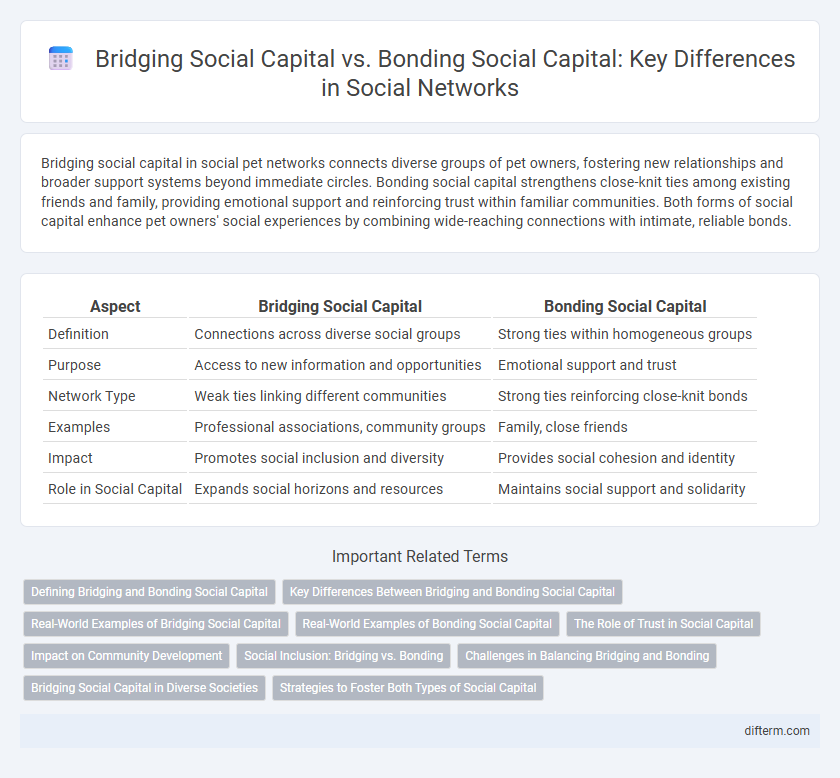Bridging social capital in social pet networks connects diverse groups of pet owners, fostering new relationships and broader support systems beyond immediate circles. Bonding social capital strengthens close-knit ties among existing friends and family, providing emotional support and reinforcing trust within familiar communities. Both forms of social capital enhance pet owners' social experiences by combining wide-reaching connections with intimate, reliable bonds.
Table of Comparison
| Aspect | Bridging Social Capital | Bonding Social Capital |
|---|---|---|
| Definition | Connections across diverse social groups | Strong ties within homogeneous groups |
| Purpose | Access to new information and opportunities | Emotional support and trust |
| Network Type | Weak ties linking different communities | Strong ties reinforcing close-knit bonds |
| Examples | Professional associations, community groups | Family, close friends |
| Impact | Promotes social inclusion and diversity | Provides social cohesion and identity |
| Role in Social Capital | Expands social horizons and resources | Maintains social support and solidarity |
Defining Bridging and Bonding Social Capital
Bridging social capital refers to connections that link individuals across diverse social groups, fostering inclusivity and access to new information and opportunities. Bonding social capital involves strong, close-knit relationships within homogeneous groups, providing emotional support and a sense of identity. Understanding the distinction between these types highlights their complementary roles in enhancing community resilience and social cohesion.
Key Differences Between Bridging and Bonding Social Capital
Bridging social capital connects diverse groups across social divides, fostering inclusivity and access to new information and opportunities, while bonding social capital strengthens ties within homogenous groups, providing emotional support and reinforcing group identity. Bridging capital tends to promote broader societal integration and innovation, whereas bonding capital offers resilience through strong intra-group loyalty and trust. Understanding these differences helps in designing social policies that balance community cohesion with cross-group collaboration.
Real-World Examples of Bridging Social Capital
Bridging social capital connects diverse groups across different social cleavages, fostering inclusivity and broad networks that enhance community resilience, as seen in neighborhood coalitions uniting various ethnic groups for local development projects. Organizations like Rotary International exemplify bridging social capital by linking professionals from distinct industries and cultures to collaborate on global humanitarian efforts. Urban community gardens also illustrate bridging social capital by bringing together residents of diverse backgrounds to collectively improve public spaces and promote social cohesion.
Real-World Examples of Bonding Social Capital
Bonding social capital strengthens close-knit relationships within homogenous groups like families, close friends, or tight-knit communities, providing emotional support and mutual aid. Real-world examples include neighborhood watch groups where residents rely on trust and shared identity to enhance safety, or immigrant enclaves that offer a network of shared cultural resources and assistance. Such bonds foster resilience and solidarity during crises by reinforcing strong interpersonal ties and shared norms.
The Role of Trust in Social Capital
Trust serves as the foundation of both bridging and bonding social capital, enabling individuals to collaborate and share resources effectively. In bonding social capital, trust fosters close-knit relationships among similar individuals, strengthening emotional support and solidarity. Bridging social capital relies on trust to connect diverse groups, facilitating access to new information and broader opportunities across social divides.
Impact on Community Development
Bridging social capital fosters inclusivity by connecting diverse groups, enhancing access to resources and opportunities, which drives innovative community development. Bonding social capital strengthens trust and cooperation within homogeneous groups, providing emotional support and reinforcing social cohesion. Both types of social capital synergize to create resilient communities capable of collective action and sustainable growth.
Social Inclusion: Bridging vs. Bonding
Bridging social capital connects diverse social groups, promoting inclusivity and access to new resources beyond immediate communities, which enhances social integration and reduces inequality. Bonding social capital strengthens ties within homogeneous groups, offering emotional support and reinforcing identity but sometimes limiting broader social inclusion. Effective social inclusion policies leverage bridging capital to create networks that foster mutual understanding and opportunity across diverse populations.
Challenges in Balancing Bridging and Bonding
Balancing bridging social capital, which connects diverse groups, and bonding social capital, which strengthens close-knit relationships, presents challenges such as managing trust levels and resource allocation. Excessive bonding social capital can lead to exclusion and insularity, while overemphasis on bridging social capital risks weakening group cohesion and shared identity. Effective strategies require nuanced approaches to foster inclusivity without diluting core community support and resilience.
Bridging Social Capital in Diverse Societies
Bridging social capital fosters connections between diverse social groups, enhancing cooperation and mutual understanding across different communities. It promotes inclusive networks that facilitate the exchange of information, resources, and opportunities beyond homogenous circles. In diverse societies, bridging social capital is essential for social cohesion, reducing inequalities, and strengthening democratic participation.
Strategies to Foster Both Types of Social Capital
Effective strategies to foster bridging social capital include promoting inclusive community events, encouraging intergroup dialogue, and supporting diverse networks that connect individuals across different social groups. To strengthen bonding social capital, prioritizing trust-building activities within close-knit groups, facilitating mutual support systems, and reinforcing shared identities are essential. Balancing both approaches enhances overall social cohesion and resilience by leveraging diverse connections and strong internal bonds.
bridging social capital vs bonding social capital Infographic

 difterm.com
difterm.com